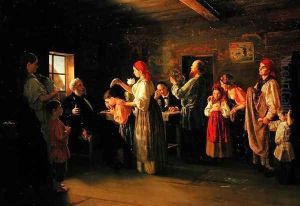Vasili Efimovich Kallistov Paintings
Vasili Efimovich Kallistov, born in 1877, was a notable figure in Russian art, whose life and career were deeply intertwined with the turbulent history of early 20th-century Russia. Kallistov's work is less known outside of Russia, partly due to the political upheavals and the overshadowing prominence of contemporaries in the Russian avant-garde. However, his contributions to Russian art, particularly in the realms of painting and graphic design, provide a fascinating glimpse into the period's artistic evolution and the socio-political context in which he worked.
Kallistov's early life was marked by an avid interest in art, leading him to pursue formal education in painting. He studied at the Moscow School of Painting, Sculpture and Architecture, an institution that played a crucial role in shaping the Russian art scene by nurturing a generation of artists who would go on to define the country's unique artistic identity. Kallistov's style initially gravitated towards realism, but he gradually embraced more experimental approaches, reflecting the broader shifts in Russian art towards Symbolism, and later, Avant-garde.
Throughout his career, Kallistov was deeply engaged with the intellectual and artistic movements of his time. He was known to have been influenced by the Mir Iskusstva (World of Art) movement, which sought to break away from academic restrictions and embraced an eclectic mix of styles, from Russian Revival to Art Nouveau. Kallistov's work from this period demonstrates his exploration of color, form, and composition, characteristics that aligned with the movement's ethos of artistic freedom and individual expression.
The 1917 Russian Revolution marked a turning point in Kallistov's life and career. Like many of his contemporaries, the socio-political upheavals of the time influenced his artistic output. In the years following the revolution, Kallistov's work reflected the dramatic changes occurring in Russian society. He delved into graphic design and illustration, contributing to the burgeoning field of propaganda art, a testament to his adaptability and engagement with the era's dominant political narratives.
Vasili Efimovich Kallistov's death in 1920 cut short a career that was both reflective of and contributory to one of the most dynamic periods in Russian art. Despite his relatively early death, Kallistov's body of work offers valuable insights into the artistic and cultural developments of his time. His paintings and graphic designs not only capture the essence of a pivotal era in Russian history but also showcase the evolution of an artist who was continually reinventing his approach in response to the changing world around him.
